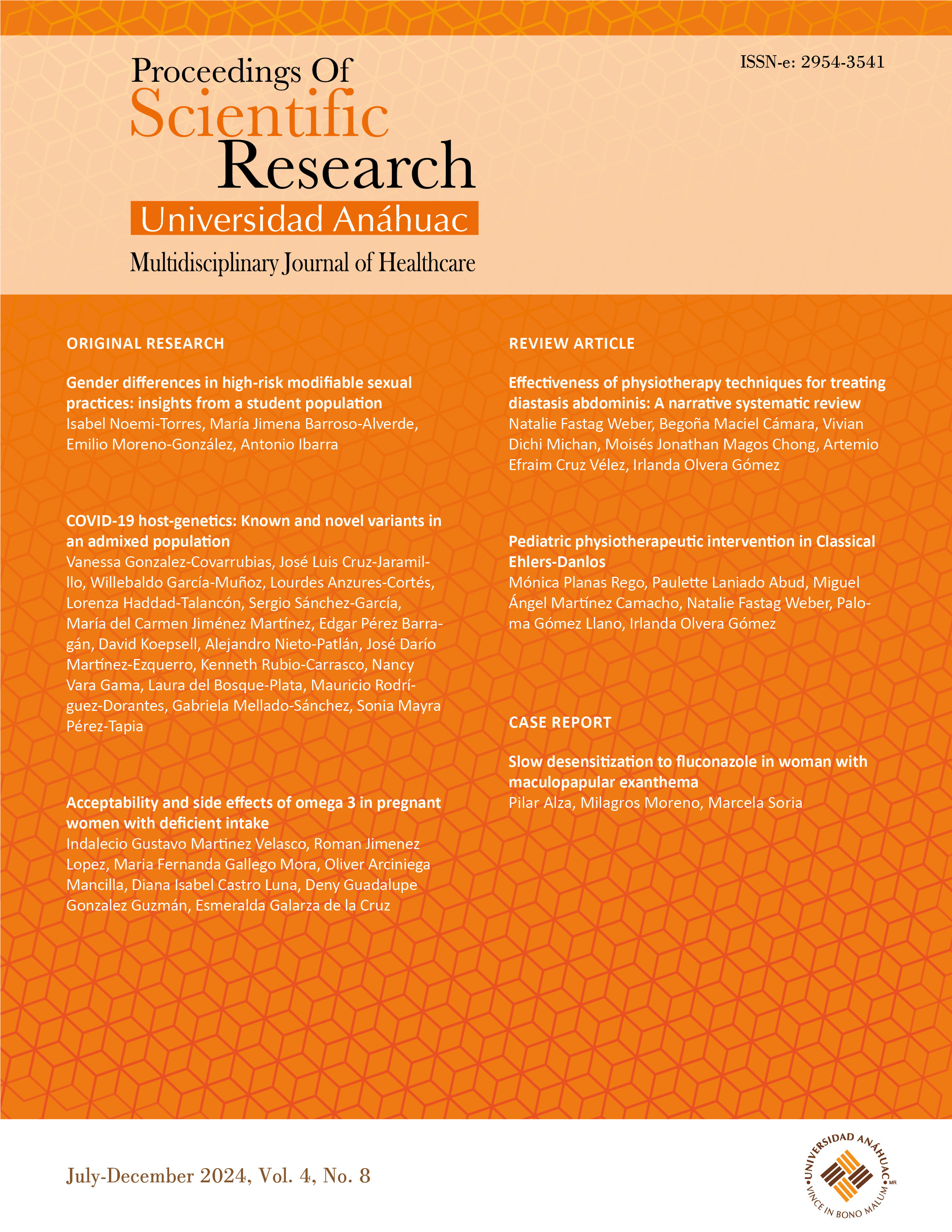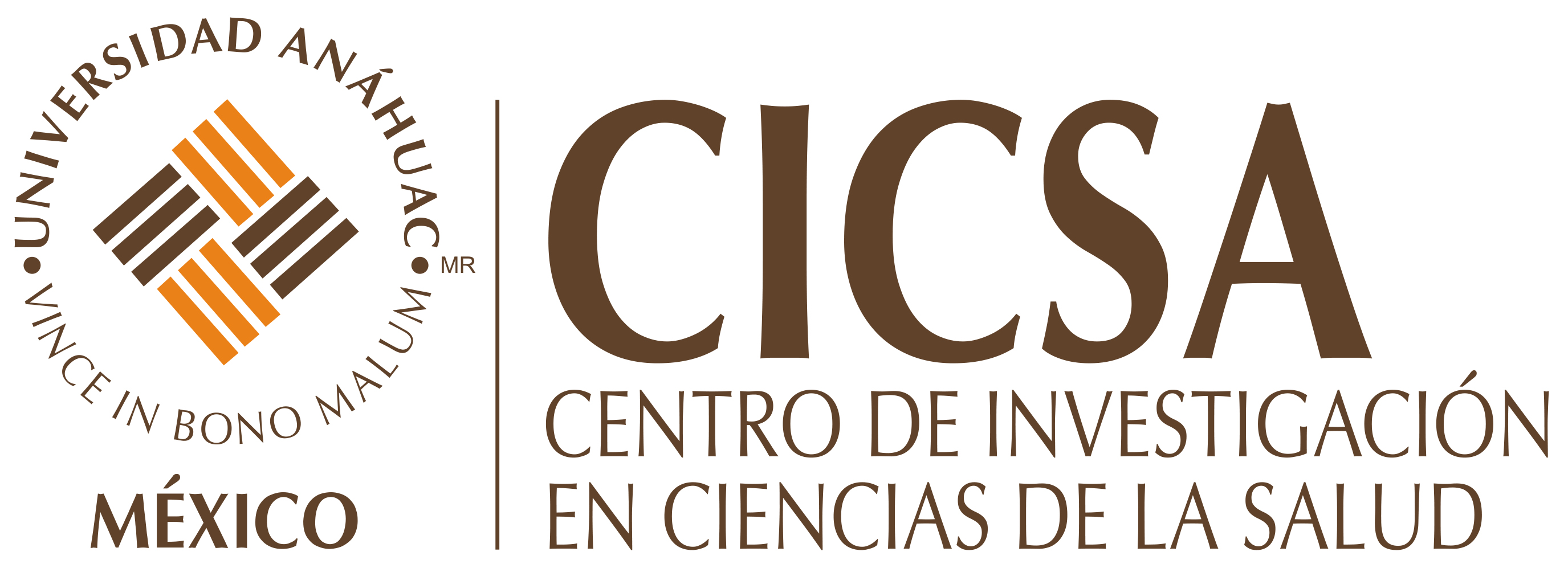COVID-19 host-genetics: Known and novel variants in an admixed population
DOI:
https://doi.org/10.36105/psrua.2024v4n8.02Keywords:
COVID-19, host genetics, gene variation, admixed populationAbstract
Introduction: The investigation of host gene variants associated to COVID-19 has led to causal relationships and potential therapeutic targets, but most of these studies have taken place in individuals of European descent. Objective: Here, we aimed to confirm allele frequency differences in host genetic variants previously associated to COVID-19 in admixed individuals i.e., Mestizos from Mexico. Genes studied included those previously reported and replicated including, ABO, CCR2, CCR9, CXCR6, DPP9, FYCO1, IL10RB/IFNAR2, LZTFL1, OAS1, OAS2, OAS3, SLC6A20, TYK2, and XCR1. Methods: DNA from 106 COVID-19 patients and 2677 individuals were genotyped using the Illumina GSA array. Variants not probed in the array or that did not pass quality controls were imputed for these 14 genes using the 1000G phase 3 hg19 as reference following current standard protocols. Allele frequencies were computed and compared between COVID-19 patients and the general population. Results: We confirmed allele frequency differences for ABO rs657152, DPP9 rs2109069, LZTFL1 rs11385942, OAS1 rs10774671, OAS1 rs2660, OAS2 rs1293767, and OAS3 rs1859330 p<0.03. In addition, we identified over 100 SNVs with significant allele frequency differences (p-value <10 -2). Of these, there were four variants on ABO, OAS1/2 and FYCO1 with a high functional impact assessed in-silico. Conclusions: our observations confirm allele frequency differences in genes associated with COVID-19 in an admixed population and prompts for the development of metanalyses to validate local and geographical patterns of COVID-19 severity and infection associated to genetic variation.
Downloads
PLUMX metrics
References
K Niemi ME, Karjalainen J, Liao RG, et al (2021) Mapping the human genetic architecture of COVID-19. Nat 2021 6007889 600:472–477. https://doi.org/10.1038/s41586-021-03767-x.
Callaway E (2021) The quest to find genes that drive severe COVID. Nature 595:346–348. https://doi.org/10.1038/s41586-021-03767-x
Cobat A, Zhang Q, COVID Human Genetic Effort, Abel L, Casanova J-L, Fellay J (2023) Human Genomics of COVID-19 Pneumonia: Contributions of Rare and Common Variants. Annu Rev Biomed data Sci. https://doi.org/10.1146/ANNUREV-BIODATASCI-020222-021705
Niemi MEK, Daly MJ, Ganna A (2022) The human genetic epidemiology of COVID-19. Nat Rev Genet 23:533. https://doi.org/10.1038/s41576-022-00478-5.
Ellinghaus D, Jostins L, Spain SL, et al (2016) Analysis of five chronic inflammatory diseases identifies 27 new associations and highlights disease-specific patterns at shared loci. Nat Genet 48:510–518. https://doi.org/10.1038/ng.3528.
Pairo-Castineira E, Clohisey S, Klaric L, et al (2020) Genetic mechanisms of critical illness in COVID-19. Nat 2020 5917848 591:92–98. https://doi.org/10.1038/s41586-020-03065-y.
Ji XS, Chen B, Ze B, Zhou WH (2022) Human genetic basis of severe or critical illness in COVID-19. Front Cell Infect Microbiol 12:1401. https://doi.org/10.3389/fcimb.2022.963239.
Semiz S (2021) SIT1 transporter as a potential novel target in treatment of COVID-19. Biomol Concepts 12:156–163. https://doi.org/10.1515/bmc-2021-0017.
Williamson EJ, Walker AJ, Bhaskaran K, et al (2020) Factors associated with COVID-19-related death using OpenSAFELY. Nat 2020 5847821 584:430–436. https://doi.org/10.1038/s41586-020-2521-4.
Sousa Neto AR de, Carvalho ARB de, Oliveira EMN de, Magalhães R de LB, Moura MEB, Freitas DRJ de (2021) Symptomatic manifestations of the disease caused by coronavirus (COVID-19) in adults: systematic review. Rev Gaúcha Enferm. https://doi.org/10.1590/1983-1447.2021.20200205
Havervall S, Falk AJ, Klingström J, et al (2022) SARS-CoV-2 induces a durable and antigen specific humoral immunity after asymptomatic to mild COVID-19 infection. PLoS One. https://doi.org/10.1371/JOURNAL.PONE.0262169
Asgari S, Pousaz LA (2021) Human genetic variants identified that affect COVID susceptibility and severity. Nature 600:390–391. https://doi.org/10.1038/d41586-021-01773-7.
Butler-Laporte G, Nakanishi T, Mooser V, et al (2021) Vitamin D and COVID-19 susceptibility and severity in the COVID-19 host genetics initiative: A Mendelian randomization study. PLoS Med. https://doi.org/10.1371/journal.pmed.1003605
Freuer D, Linseisen J, Meisinger C (2021) Impact of body composition on COVID-19 susceptibility and severity: A two-sample multivariable Mendelian randomization study. Metabolism. https://doi.org/10.1016/J.METABOL.2021.154732,
Leong A, Cole JB, Brenner LN, Meigs JB, Florez JC, Mercader JM (2021) Cardiometabolic risk factors for COVID-19 susceptibility and severity: A Mendelian randomization analysis. PLoS Med. https://doi.org/10.1371/JOURNAL.PMED.1003553
Wendt FR, De Lillo A, Pathak GA, De Angelis F, COVID-19 Host Genetics Initiative, Polimanti R (2021) Host Genetic Liability for Severe COVID-19 Associates with Alcohol Drinking Behavior and Diabetic Outcomes in Participants of European Descent. Front Genet 12:765247. https://doi.org/10.3389/fgene.2021.765247.
Santesmasses D, Castro JP, Zenin AA, Shindyapina A V, Gerashchenko M V, Zhang B, Kerepesi C, Yim SH, Fedichev PO, Gladyshev VN (2020) COVID-19 is an emergent disease of aging. medRxiv. https://doi.org/10.1101/2020.04.15.20060095
Zhu N, Zhang D, Wang W, et al (2020) A Novel Coronavirus from Patients with Pneumonia in China, 2019. N Engl J Med 382:727–733, https://doi.org/10.1056/NEJMOA2001017.
Global Facts. https://globalhealth5050.org/the-sex-gender-and-covid-19-project/
Takahashi T, Ellingson MK, Wong P, et al (2020) Sex differences in immune responses that underlie COVID-19 disease outcomes. Nat 2020 5887837 588:315–320, https://doi.org/10.1038/s41586-020-2700-3.
Li Y, Jerkic M, Slutsky AS, Zhang H (2020) Molecular mechanisms of sex bias differences in COVID-19 mortality. Crit Care. https://doi.org/10.1186/S13054-020-03118-8
Tsiambas E, Chrysovergis A, Papanikolaou V, et al (2020) Chromosome X riddle in SARS-CoV-2 (COVID-19) - related lung pathology. Pathol Oncol Res 26:1, https://doi.org/10.1007/S12253-020-00878-0.
Tümer M, Kiliçaslan B, Akinci SB (2021) The power of X-chromosome in COVID-19. Anesth Analg 1966–1966, https://avesis.hacettepe.edu.tr/yayin/56d0fdef-8fc3-419e-bb16-fbac5cc9b56c/the-power-of-x-chromosome-in-covid-19.
Mueller AL, Mcnamara MS, Sinclair DA (2020) Why does COVID-19 disproportionately affect older people? Aging (Albany NY) 12:9959, https://doi.org/10.18632/AGING.103344.
Nanovskaya T, Patrikeeva S, Zhan Y, Fokina V, Hankins GD V, Ahmed MS (2012) Transplacental transfer of vancomycin and telavancin. Am J Obstet Gynecol. https://doi.org/10.1016/j.ajog.2012.06.064
Daniloski Z, Jordan TX, Wessels HH, et al (2021) Identification of Required Host Factors for SARS-CoV-2 Infection in Human Cells. Cell 184:92-105.e16 https://doi.org/10.1016/j.cell.2020.10.030.
Dite GS, Murphy NM, Allman R (2021) An integrated clinical and genetic model for predicting risk of severe COVID-19: A population-based case–control study. PLoS One. https://doi.org/10.1371/JOURNAL.PONE.0247205
Dite GS, Murphy NM, Allman R (2021) Development and validation of a clinical and genetic model for predicting risk of severe COVID-19. Epidemiol Infect. https://doi.org/10.1101/2021.03.09.21253237
Huffman JE, Butler-Laporte G, Khan A, et al (2022) Multi-ancestry fine mapping implicates OAS1 splicing in risk of severe COVID-19. Nat Genet. https://doi.org/10.1038/S41588-021-00996-8
Gemmati D, Tisato V (2020) Genetic hypothesis and pharmacogenetics side of renin-angiotensin-system in COVID-19. Genes (Basel) 11:1–17, https://doi.org/10.3390/genes11091044
Aydillo T, Esther Babady N, Kamboj M (2020) Mining a GWAS of Severe Covid-19. https://doi.org/101056/NEJMc2025747 383:2588–2589
Shelton JF, Shastri AJ, Ye C, et al (2021) Trans-ancestry analysis reveals genetic and nongenetic associations with COVID-19 susceptibility and severity. Nat Genet 2021 536 53:801–808, https://doi.org/10.1038/s41588-021-00854-7
Liu EY, Li M, Wang W, Li Y (2013) MaCH-admix: genotype imputation for admixed populations. Genet Epidemiol 37:25–37, https://doi.org/10.1002/gepi.21690
Uffelmann E, Huang QQ, Munung NS, de Vries J, Okada Y, Martin AR, Martin HC, Lappalainen T, Posthuma D (2021) Genome-wide association studies. Nat Rev Methods Prim 2021 11 1:1–21, https://doi.org/10.1038/s43586-021-00056-9
Clarke GM, Anderson CA, Pettersson FH, Cardon LR, Morris AP, Zondervan KT (2011) Basic statistical analysis in genetic case-control studies. Nat Protoc 6:121–133, https://doi.org/10.1038/nprot.2010.182
Purcell S, Neale B, Todd-Brown K, et al (2007) PLINK: a tool set for whole-genome association and population-based linkage analyses. Am J Hum Genet 81:559–575, https://doi.org/10.1086/519795
Alexander DH, Lange K (2011) Enhancements to the ADMIXTURE algorithm for individual ancestry estimation. BMC Bioinformatics 12:1–6, https://doi.org/10.1186/1471-2105-12-246
Bryc K, Velez C, Karafet T, Moreno-Estrada A, Reynolds A, Auton A, Hammer M, Bustamante CD, Ostrer H (2010) Genome-wide patterns of population structure and admixture among Hispanic/Latino populations. PNAS 107:8954–8961, https://doi.org/10.1186/1471-2105-12-246
Gonzalez-Covarrubias V, Morales-Franco M, Cruz-Correa OF, et al (2019) Variation in actionable pharmacogenetic markers in natives and mestizos from Mexico. Front Pharmacol 10:1169, https://doi.org/10.3389/fphar.2019.01169
Team RC (2014) A Language and Environment for Statistical Computing, http://www.R-project.org.
Butler JM, Hall N, Narendran N, Yang YC, Paraoan L (2017) Identification of candidate protective variants for common diseases and evaluation of their protective potential. BMC Genomics 18:575, https://doi.org/10.1186/s12864-017-3964-3
McLaren W, Gil L, Hunt SE, Riat HS, Ritchie GRS, Thormann A, Flicek P, Cunningham F (2016) The Ensembl Variant Effect Predictor. Genome Biol 17:122, https://doi.org/10.1186/s12864-017-3964-3
Roberts GHL, Partha R, Rhead B, et al (2022) Expanded COVID-19 phenotype definitions reveal distinct patterns of genetic association and protective effects. Nat Genet 54:374–381 https://doi.org/10.1038/s41588-022-01042-x
Institutional Repository for Information Sharing IRIS-PAHO, WHO. https://iris.paho.org/handle/10665.2/30324.
Yildirim Z, Sahin OS, Yazar S, Bozok Cetintas V (2021) Genetic and epigenetic factors associated with increased severity of Covid-19. Cell Biol Int 45:1158–1174, https://doi.org/10.1002/cbin.11572
Deleers M, Breiman A, Daubie V, et al (2020) Covid-19 and blood groups: ABO antibody levels may also matter. Int J Infect Dis. https://doi.org/10.1016/j.ijid.2020.12.025, https://doi.org/10.1002/cbin.11572
Solmaz İ, Araç S (2020) ABO blood groups in COVID-19 patients; Cross-sectional study. Int J Clin Pract. https://doi.org/10.1111/ijcp.13927, https://doi.org/10.1111/ijcp.13927
Rinninella E, Raoul P, Cintoni M, Franceschi F, Miggiano GAD, Gasbarrini A, Mele MC (2019) What is the healthy gut microbiota composition? A changing ecosystem across age, environment, diet, and diseases. Microorganisms. https://doi.org/10.3390/MICROORGANISMS7010014
Zeberg H, Pääbo S (2020) The major genetic risk factor for severe COVID-19 is inherited from Neanderthals. Nat 2020 5877835 587:610–612, https://doi.org/10.1038/s41421-022-00488-x
Shen Y, Wang J, Li Y, Zhang Y, Tian R, Yan R (2022) Structures of ACE2–SIT1 recognized by Omicron variants of SARS-CoV-2. Cell Discov 2022 81 8:1–4, https://doi.org/10.1038/s41421-022-00488-x
Matuozzo D, Talouarn E, Marchal A, et al (2023) Rare predicted loss-of-function variants of type I IFN immunity genes are associated with life-threatening COVID-19. Genome Med 15:22, https://doi.org/10.1186/s13073-023-01173-8
Pojero F, Candore G, Caruso C, Di Bona D, Groneberg DA, Ligotti ME, Accardi G, Aiello A (2021) The Role of Immunogenetics in COVID-19. Int J Mol Sci 2021, Vol 22, Page 2636 22:2636, https://doi.org/10.3390/ijms22052636
Rescenko R, Peculis R, Briviba M, et al (2021) Replication of LZTFL1 Gene Region as a Susceptibility Locus for COVID-19 in Latvian Population. Virol Sin 36:1241–1244, https://doi.org/10.1007/s12250-021-00448-x
Alkafaas SS, Abdallah AM, Hassan MH, et al (2024) Molecular docking as a tool for the discovery of novel insight about the role of acid sphingomyelinase inhibitors in SARS- CoV-2 infectivity. BMC Public Health 24:395, https://doi.org/10.1186/s12889-024-17747-z
Minnai F, Biscarini F, Esposito M, et al (2024) A genome-wide association study for survival from a multi-centre European study identified variants associated with COVID-19 risk of death. Sci Rep 14:3000, https://doi.org/10.1038/s41598-024-53310-x

Downloads
Published
How to Cite
Issue
Section
License
Copyright (c) 2024 Vanessa Gonzalez-Covarrubiasa, José Luis Cruz-Jaramilllo, Willebaldo García‐Muñoz, Lourdes Anzures-Cortés, Lorenza Haddad-Talancón, Sergio Sánchez-García, María del Carmen Jiménez Martínez, Edgar Pérez Barragáne, David Koepsell, Alejandro Nieto-Patlán, José Darío Martínez-Ezquerro, Kenneth Rubio-Carrascoa, Nancy Vara Gama, Laura del Bosque-Plata, Mauricio Rodríguez-Dorantes, Gabriela Mellado-Sánchez, Sonia Mayra Pérez-Tapia

This work is licensed under a Creative Commons Attribution-NonCommercial-NoDerivatives 4.0 International License.
All the intellectual content found in this publication is licensed to the consumer public under the figure of Creative Commons©, unless the author of said content has agreed otherwise or limited said faculty to "Proceedings of Scientific Research Universidad Anáhuac. Multidisciplinary Journal of Healthcare©" or "Universidad Anáhuac Mexico©" in writing and expressly.
Proceedings of Scientific Research Universidad Anáhuac. Multidisciplinary Journal of Healthcare is distributed under a Creative Commons Attribution-NonCommercial-NoDerivatives 4.0 International License.
The author retains the economic rights without restrictions and guarantees the journal the right to be the first publication of the work. The author is free to publish his article in any other medium, such as an institutional repository.












